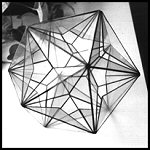Little Adventures
*
Model Maker
 When I first began making polyhedra, I built my models out of colored file folders.
After selecting the model I wanted to make from Mathematical Models, I would draw
the required parts on a large index card, and then use a needle to prick through
this master copy onto the colored file folder beneath. Once I had the required number
of duplicates, I connected the prick marks using a straight edge and a pencil, cut
out the parts and assembled the model. I soon had about a dozen such models and was
beginning to think myself pretty good at building them, when I discovered a book
called Polyhedron Models written by Magnus J. Wenninger. In 1959, Wenninger became
interested in building polyhedra. Over the next few years, he built all of those
shown in Mathematical Models, but he did not stop there. By collecting books on polyhedra
and by doing a great deal of exploration on his own, Wenninger eventually built a
collection of well over 100 models that he displayed on the back wall of his mathematics
classroom. His book, Polyhedron Models, contains photographs of 119 of these… everything
from a tetrahedron to the truly amazing small inverted retrosnub icosicosidodecahedron,
which took over 100 hours to construct. I was entranced by the beauty of Wenninger's
work, but as I set about building some of his simpler models, I knew that I would
never have his monomania for the subject. The best I could hope for was to be able
to build models that looked as good as his.
When I first began making polyhedra, I built my models out of colored file folders.
After selecting the model I wanted to make from Mathematical Models, I would draw
the required parts on a large index card, and then use a needle to prick through
this master copy onto the colored file folder beneath. Once I had the required number
of duplicates, I connected the prick marks using a straight edge and a pencil, cut
out the parts and assembled the model. I soon had about a dozen such models and was
beginning to think myself pretty good at building them, when I discovered a book
called Polyhedron Models written by Magnus J. Wenninger. In 1959, Wenninger became
interested in building polyhedra. Over the next few years, he built all of those
shown in Mathematical Models, but he did not stop there. By collecting books on polyhedra
and by doing a great deal of exploration on his own, Wenninger eventually built a
collection of well over 100 models that he displayed on the back wall of his mathematics
classroom. His book, Polyhedron Models, contains photographs of 119 of these… everything
from a tetrahedron to the truly amazing small inverted retrosnub icosicosidodecahedron,
which took over 100 hours to construct. I was entranced by the beauty of Wenninger's
work, but as I set about building some of his simpler models, I knew that I would
never have his monomania for the subject. The best I could hope for was to be able
to build models that looked as good as his.
On a gusty Friday in June 1980, Pam and I sought refuge from the wind by exploring the Science Museum in South Kensington, London. There we saw the first locomotive, The Rocket, and Charles Babbage's Difference Engine, an early attempt at a mechanical computer. As we turned away from Babbage's creation, we saw a glass case filled with polyhedron models… the first such models, other than my own, that I had ever seen in the flesh. These were the work of one of the men who wrote Mathematical Models, and this made me feel that I was looking at the work of a friend. My friend could certainly build polyhedron models… they were colorful, very neatly done, and much, much more complicated than anything I was ever likely to attempt. As I walked away, I found myself dissatisfied that my own models were really just pale imitations of the work of master model builders. What could I do to make my polyhedron models distinctively mine?
Back home in Delaware, Pam and I tried a new idea… we built a great dodecahedron out of window glass. We began by making a triangle of the correct shape of cardboard, then traced around this with a glass marking pen. Guided by these lines, Pam cut the required sixty pieces of glass. To hold the pieces together, we used a plastic grouting compound that was originally intended for caulking bathroom tiles and tubs. This stuff started out very gooey, but after a time turned into a sort of tough rubber. Assembling the model was a messy and slow process, but when the excess rubber had been trimmed off with a razor blade, and the glass had been polished inside and out, we had the beautiful model that you see above. Here was a polyhedron model that was different and distinctively ours!
In my next attempt at a distinctive model, I used a piece of glass from the Crystal Palace to make a great dodecahedron out of photographs. The piece of glass had a symmetric star pattern pressed into it. When you placed pieces of colored paper behind it and held it up to the light, various pleasingly symmetric color patterns emerged. I put my camera on a tripod and took twelve pictures of each of five different color patterns. I glued these sixty pictures to index cards, and then cut out the parts that I would need to make a great dodecahedron. It took an evening spent with scotch tape straps and Elmer's Glue to assembled the pictures into a model. The finished polyhedron was unique and visually interesting, but it took too much time and money to create.